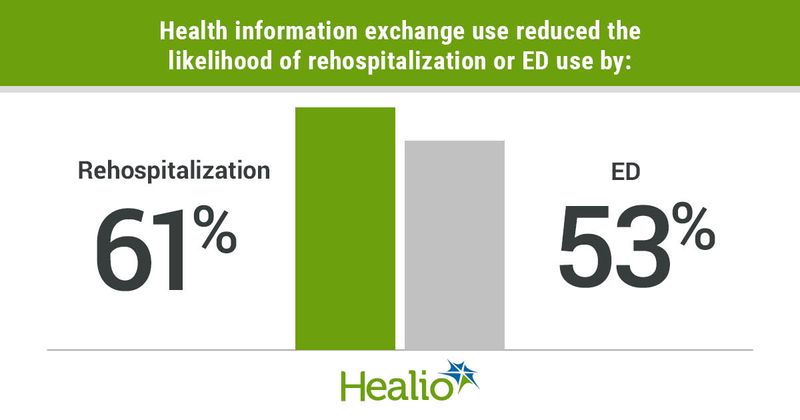Community health information exchange reduces ED visits, rehospitalization
Click Here to Manage Email Alerts
Primary care physicians who used a community health information exchange significantly improved their patients’ transition from hospitalization to outpatient care, according to findings published in Annals of Family Medicine.
Chantel Sloan-Aagard, PhD, an associate professor at Brigham Young University, and colleagues wrote that the United States health care system is “markedly fragmented” as patients move through various types of care.

Sloan-Aagard told Healio that patients often undergo a variety of tests, imaging and treatment while in emergency hospital or inpatient care and receive instructions after discharge.
“Helping patients reconcile those medications with others they are taking, confirm that they understand and are following discharge instructions and continuing to update imaging and test results usually falls to their primary care physician,” Sloan-Aagard said. “If physicians are unaware of a recent hospital visit, what precluded it, and the results, it can hamper the quality of care they are able to give their patients going forward.”
Electronic health records were designed to enhance care coordination, but there are various issues that make it difficult to share information, according to the researchers. Health information exchanges (HIEs) were developed to address these gaps in data sharing by merging EHRs into a single database.
Sloan-Aagard and colleagues wrote that few studies have assessed how a community HIE might impact primary care transitions. To better understand the possible associations, the researchers investigated the use of the nonprofit Paso del Norte Health Information Exchange (PHIX) in El Paso, Texas.
Study coauthor Scott B. Crawford, MD, an associate professor at the Texas Tech University Health Sciences Center and executive director of the Training and Educational Center for Healthcare Simulation, told Healio that community HIEs like PHIX improve access to information and change the ways in which primary care clinicians can interact with records.
“This is likely novel compared to the systems available to them when they trained,” he said. “Because the system of getting follow-up records was so cumbersome previously — fax machine requests and physical print-outs — tools like PHIX can drastically improve the ability to obtain these records and make them more usable to clinicians.”
For the study, the researchers evaluated data from a retrospective cohort of 8,216 hospital inpatients aged 18 years or older who were discharged from Jan. 1, 2021, through Nov. 30, 2021. All of the patients saw their PCP within a month of discharge.
Of the 8,216 patients in the cohort, 1,780 were controls and the remainder were divided into two comparison groups: 2,627 who were rehospitalized and 3,809 who visited an ED during the follow-up window.
Sloan-Aagard, Crawford and colleagues found that HIE-lookup reduced the likelihood of rehospitalization by 61% and ED use by 53%. Also, for patients who were rehospitalized, the median length of time to the subsequent visit more than doubled when PCPs used HIE. In addition, HIE use increased the median time to ED use after inpatient discharge from 99 to 238 patient days.
Additional factors, like age, gender, insurance and ethnicity, were also “significant predictors of hospital reuse,” the researchers wrote.
“Our study demonstrates that, in care transitions from hospitals to primary care, the use of data from an exchange can have dramatic impacts on the patient’s need to reuse hospital services,” Sloan-Aagard said.
However, the researchers also found that PCPs looked up just 270 — or 3.29% — of the patients in the HEI within 2 days before or after their visit.
“Our research shows that very often there is no follow up with a primary care provider within the first month after a hospital discharge, and that even when the hospitalization data are available through an exchange, primary care physicians often do not reference it prior to or soon after caring for a patient,” Sloan-Aagard said. “Our study demonstrates that in care transitions from hospitals to primary care, the use of data from an exchange can have dramatic impacts on the patients’ need to reuse hospital services.”
The reasons for this, she said, “are varied, but often include the physician thinking they have all the information from a patient already.”
Additionally, just 16% of patients who were discharged from hospital visits followed up with their PCP in the 30-day window.
“We suspect ... there is a need for increased efforts to be sure patients visit their primary care physicians promptly for follow-ups,” the researchers wrote.
Sloan-Aagard, Crawford and colleagues concluded that PCPs’ increased utilization of community HIEs “may dramatically increase the time until inpatient or ED reuse.”
“The take-home message for primary care providers is that reviewing your patient’s records from recent hospital stays can help them from having to go back to inpatient care,” Sloan-Aagard said. “All the reasons for this are not clear yet. However, where exchanges are available, we encourage their increased use to support the transition of care from hospital to primary providers.”
